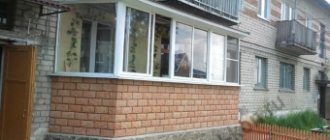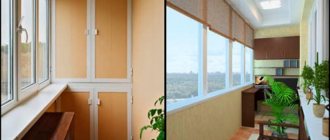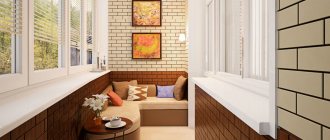Many standard residential complexes do not require a balcony or loggia on the ground floor. But those who live below also dream of getting their share of fresh air, so they often build an extension on their own, using a foundation made of piles, or turn to contractor companies specializing in this area.
Of course, it is difficult to acquire extra square meters in this way, but it is much more difficult, as practice shows, to then officially legitimize the attached balcony. You have to spend a lot of effort and time, go through all the circles of bureaucratic hell.
But the procedure for documenting an extension on the ground floor can be significantly simplified if you obtain official permission for the construction of the described object in advance. Otherwise, the apartment will have serious encumbrances.
It will be difficult to sell it in the future, or to register rights to such real estate if it is left as an inheritance. When executing any transaction, BTI will definitely pay attention to the unauthorized extension and will initiate its demolition through the court.
Position of the authorities
Be that as it may, according to all documents, any addition of additional structures to a high-rise residential building is regarded as a balcony. Accordingly, in order to obtain permits for its construction, it is necessary to collect a number of documents and approvals on the design documentation.
Permission to build a balcony
Getting permission
The procedure for obtaining a construction permit is prescribed in Article 51, Part 2 of the Town Planning Code of the Russian Federation. The algorithm of actions will be as follows:
- We write an application for a permit to the Department of Town Planning Permits of your locality;
- We request documents for the land from the management company or DEZ (cadastral plan and certificate of status of the land plot), regardless of the number of floors of the future balcony. We attach them to the application;
- We initiate a general meeting of all owners of the apartment building to obtain their consent in the form of a Protocol.
Project development
Drafting
Having received permission from officials, we order a balcony construction project from an architectural bureau.
After receiving it, we contact:
- Fire authorities;
- Gas industry, which manages the residential building;
- To the energy supply organization;
- In the heating network, city water utility and SES.
Permission from the energy supply organization
After all, the construction of a balcony will certainly affect many engineering networks within the house, since attached balconies are often turned into living rooms; accordingly, they are equipped with heating sources and electrical networks.
In addition, an attached or hanging balcony should not impair the passage of daylight into the living spaces of your neighbors.
If there is no conclusion about insolation (degree of illumination), then the shape and dimensions of the balcony must be changed. A similar rule also applies to the desires of homeowners with balconies who are wondering whether permission is needed to glaze a standard-shaped balcony.
By the way, the neighbors of the apartment in which they are going to build a balcony are primarily concerned about the deterioration of illumination. As a rule, the first floors are easier to coordinate, but problems often arise when preparing documentation for the construction of a balcony on the upper floors.
Technical passport of the apartment
Don’t forget that when arranging a balcony you will also have to visit the city BTI twice:
- The first time to obtain copies of documents for submitting an application to the Town Planning Department;
- The second time to order and produce a new technical passport - after all, your living space will change thanks to the built balcony.
Registration of these documents for the balcony is also necessary to ensure that in the future there are no difficulties when selling your home. But before receiving a new technical passport, it is necessary to hire a construction organization that will build a balcony, and then submit the work to a special selection committee.
In addition to a representative of the design organization responsible for the development of technical documentation, the commission includes employees of various public utilities and a representative of the state administration. After drawing up the Acceptance Certificate and its approval, you can contact the BTI.
Conclusions: as you can see, obtaining permission to acquire additional residential meters in the form of a balcony being built involves obtaining many approvals.
In no case should they be neglected, since city authorities may well demand that the building be restored to its original appearance if your actions are deemed illegal.
Types of objects that are subject to the notification procedure
The construction of the following types of real estate objects is subject to the notification procedure:
— Individual residential building;
- Garden house.
Information: The simplified procedure for registering residential or garden houses on garden plots of land ended on March 1, 2022. Therefore, now, construction on garden land is possible only after sending a notice of the planned construction.
It is not required to notify the Administration about the construction of such auxiliary buildings as a bathhouse, garage, barn.
In case the developer before 08/03/2018 If a permit for the construction of a residential building has already been received, there is no need to additionally notify the Administration about the start of construction.
Important: Construction can only be carried out on a demarcated plot of land. Therefore, before submitting a notice of planned construction, make sure that the land plot being developed is demarcated
You can check this by following the instructions in the article.
Tips and nuances for adding a balcony to the first floor of a building
There are a number of individual points that relate to the addition of a balcony to an apartment on the first floor of the building. From a construction point of view, it is worth considering the following nuances:
- Any type of balcony must have a very solid foundation. This is especially true in cases where it is planned to expand the space of the living room through partial or complete combination of premises;
- The foundation of the balcony must fit tightly to the foundation of the building. The quality of further insulation of the room depends on this;
- The roof must be installed at an angle;
- Under no circumstances should the door open into the balcony. The surest option is when the door opens into the room. Firstly, it will save space on a small balcony, and secondly, it will protect you from situations with plastic doors “slamming”;
- Choosing stained glass or panoramic glazing for a balcony attached to an apartment on the first floor of a building is a bad idea. In this case, you should take special care of security and at least install bars on the balcony windows, or even better, an alarm system.
And a little about the legal side of the issue:
- A solid strip foundation is the most reliable option, but before installing it, be sure to consult with lawyers. The fact is that the city authorities can force you to pay for the part of the land on which the foundation was erected, since in this case it passes from public use to your personal property;
- Obtaining permission to add a balcony on the second floor is much more difficult. A good option is when the neighbors below have already built a balcony for themselves, and it can serve as a support for the structure on the second floor. Otherwise, the structure must be supported on special supports that do not threaten the integrity of the load-bearing wall of the building;
- Remember that collecting documents and permits before construction begins is much easier and cheaper than trying to legalize an extension after it has been completed;
- It is almost impossible to make a design for an attached balcony yourself. To do this, it is better to turn to specialists, because they are already familiar with all the possible nuances and pitfalls of approving and legitimizing such buildings.
Adding a balcony to an apartment on the first floors of a building is a very complex and lengthy process, which should be approached with special responsibility. You can independently carry out such a redevelopment only after thoroughly studying all the nuances of the legal legitimization of such structures and the technological side of the issue. But the easiest option would be to contact a trusted construction company that has successful experience in implementing similar projects.
Intermediary services
Often people who want to add a balcony to their home turn to intermediary companies for help. This way it will be much calmer to wait for the upcoming construction, because you will not need to run through various authorities to obtain permits, the company will do everything for you.
In addition,
experienced firms usually have their own connections in the relevant organizations , and obtaining permits there will be much easier for them than doing it yourself.
And the skills of the firm’s experienced lawyers will help to quickly legitimize an existing project if there are any reasons for refusal.
The services of such a company can be expensive ( another 60-100 thousand to the total cost ) and you should immediately decide for yourself whether the balcony is worth such costs.
Attention! You need to be careful when choosing an intermediary company and be wary if they offer to prepare all the documents in a couple of weeks. As a rule, this takes at least 4 months. Work only with trusted, experienced companies that have been on the market for similar services for a long time.
Methods for building a balcony on the first floor
The construction of a balcony on the first floor is carried out in two ways. Supported and suspended structures are used.
Wall-mounted options are fixed to the walls using special brackets. They are attached to the wall using anchor bolts. A very wide structure cannot be built this way, but it will not touch the ground. This will free you from some of the approvals.
The structure on supports can be larger, because it has less impact on the wall. The maximum load is placed on the foundation elements (supports). If desired, you can arrange a basement below.
Suspended design option
To make a suspended balcony on the first floor, a project is required. It includes a drawing of the balcony, in accordance with which step-by-step work is carried out.
The basis of the design is a frame made of metal elements. The basis of the design are struts. They are right triangles. One side of such a triangle is attached to the wall, the second side will support the floor, and the third from the bottom creates a supporting rib.
Rice. 3 Hanging balcony on the first floor
All struts are assembled into a single support system using a lower bandage. Stands are attached to them on top, which will become the basis for the fence and the supporting element for the canopy. At the top, the racks are connected to each other by an upper bandage.
Rice. 4 To make a balcony, assemble the base
A fence is placed along the perimeter of the balcony structure. It must be at least a meter high from the floor level. The remaining space is filled with glazing or left open.
After creating the frame, the homemade balcony is sheathed. They start with laying the floor. On such a structure, you should not fill the screed, because... she's too heavy. To make the floor, sheet material is laid on the frame. Its surface is covered with a vapor barrier film. Boards are placed on top to create a subfloor. They are attached to the base with bolts.
Rice. 5 Manufacturing of balconies on the 1st floor - diagram
The subfloor is covered with waterproofing. Logs and insulation are laid on it. Another layer of waterproofing and flooring is placed on top, on which the flooring is laid.
Rice. 6 Construction of balconies - flooring
The balcony structure is covered with a roof. To do this, a sheathing is attached to the upper frame, waterproofing and roofing are laid. If there are loggias on the 2nd floor, then a separate structure is not required. The floor of the balcony on the second floor will become the roof. All that remains is to install the visor.
Construction is completed by covering the walls with corrugated sheets, sandwich panels or other materials. Next, you can perform glazing, insulation and interior finishing of the new structure. The result is beautiful and comfortable spaces. We must not forget about the need to make a door inside, into the room.
Balcony structure on supports
Extension of a balcony on the ground floor using supports differs only in the need for excavation work. The supports can be a strip, column or pile foundation. The easiest option to install is the pile option.
Concrete or metal columns are used as piles. They dig holes under them about sixty centimeters deep. A cushion of crushed stone about twenty centimeters thick is placed at the bottom.
Rice. 7 Making balconies on supports
The posts are installed in holes and secured using spacers. The gap between the walls of the pit and the column is filled with concrete.
When the concrete has hardened, the bottom trim is attached, creating a support frame. The part running along the wall is secured to its surface with self-tapping screws.
Rice. 8 Scheme of how to make a balcony on the first floor
Stiffening ribs are installed on the frame at a distance of half a meter between them. Further, the scheme of work is similar to that described for the previous version of the balcony.
Under the floor of such a balcony you can equip a cellar. To do this, a hatch is made in the floor of the structure. A hole of the required dimensions is dug under the floor. The distance between the Earth and the balcony floor is covered with brickwork or other material. The walls of the resulting cellar are insulated.
The arrangement of the cellar should begin before laying the foundation. It is more convenient to dig a hole and arrange it when there is no structure at the top. Do not forget that you must also obtain permission in advance for the cellar.
Using support technology you can increase the balcony. Structures built in this way are used in any field. They are used for both storage space and living quarters. The presence of supports increases the possible area. However, no matter how the balcony is expanded, you must first obtain permission to carry out the work.
How to legitimize self-construction
Have you built a balcony and want to legitimize it retroactively? According to the law, you can contact your local administration with a corresponding application. A government representative will draw up an act, and you will have to pay a certain amount - a fine.
Then there is the procedure for collecting the same certificates. There is no talk of a specific completion date. You can collect them in a few months, or you can stretch out the “pleasure” for years. In the same way, it is possible to turn to intermediaries; they are more willing to take on cases of unauthorized construction - obviously, it is a little easier to achieve resolution there.
Unofficially, it is understood that building and then legalizing a balcony is easier and more reliable than seeking permission for a project that has not yet been implemented.
The only thing you should worry about in advance is the consent of your neighbors. Well, establish contact with a reliable intermediary. He, using connections in the BTI authorities, will help to ensure that the representative who appears to draw up the act turns a blind eye to some inconsistencies and signs all the necessary certificates.
Of course, no one is going to officially recommend this method. And it won't be cheap. In large cities and central regions, none of the officials will take such risks. Perhaps this option will work somewhere on the periphery - in cases that are not the most serious.
Where to complain to neighbors about illegal work
Redevelopment must be agreed upon with local government authorities. The owner must have a project. Since repairs may violate the rights of neighbors, you need to find out in advance where to complain about illegal actions.
You can also come to the municipality if the offender lives in a privatized apartment. The authority can check the legality or illegality of the redevelopment. You need to contact the general department or reception. A response to the request is given after 30 days. It is allowed to send an electronic or registered letter to the authority.
Justice can also be restored with the help of the State Housing Inspectorate. The appeal can be either written or electronic. After verification, the violator may be held accountable. In addition, the organization may oblige the owner to restore the previous appearance of the residential premises.
The prosecutor's office also deals with issues of illegal redevelopment. During the inspection it will be possible to inspect the premises. If the apartment is not restored after the order, the case will be sent to court. If there is no result in this case, criminal prosecution is possible
To avoid problematic issues with regulatory organizations and neighbors, it is important to pre-coordinate the redevelopment
Find out how to combine the kitchen with the living room.
Read about how to renovate and remodel your bathroom here.
Reasons for refusal
Quite often it happens that licensing authorities simply do not give the right to legalize construction or glazing. This can happen for a variety of reasons, which we will now consider.
It is not allowed to unauthorizedly add balconies on the central streets of the city if they were not previously provided for by the project during the construction of the house. If you are planning a redevelopment that includes work, including its expansion, be sure to read such documentation, otherwise a wide variety of problems may fall on your shoulders, including dismantling an already built balcony at your own expense. In some cases, even simple glazing becomes impossible, so don’t rush, read this issue in more detail.
Extension work, reconstruction and other processes are often impossible in buildings that are architectural monuments.
You cannot add balconies when expansion or redevelopment entails work on load-bearing walls, or more precisely, their dismantling or partial destruction.
Therefore, you should remember that when submitting documents for the construction of a balcony in such a house or its expansion, in most cases you will simply receive a refusal even to glaze it.
An extension is not possible if its construction will modify or worsen the appearance of the house. Therefore, it is recommended to immediately order an expert opinion. It may become the basis for permission or refusal of extension and expansion.
City authorities may refuse construction if outdated technologies or materials are used. you must collect documentation that will prove that the technologies and materials will not contribute to the destruction of the house, they are absolutely safe not only for the structure, but also for those living in it.
You cannot add balconies when expansion or redevelopment entails work on load-bearing walls, or more precisely, their dismantling or partial destruction. They may refuse to legalize a balcony or extension when underground utilities are located close to the structure. Construction is permissible only if they are no closer than 2.5 m from the foundation of the extension.
Waiting for an answer
The administration can consider a package of all the listed documents for up to 45 days, then it is obliged to decide on permission or refusal. But he must also be motivated. What does it mean? Let's look at the exact reasons why you may be refused.
If a balcony on the ground floor is prohibited, citing the building’s belonging to cultural values or architectural monuments, then such a verdict must be accompanied by an official extract from the register of such values. It must indicate by whom, in what time frame and on the basis of what document the building was classified as a particularly important historical monument. If you were not given such an extract, the refusal is not considered motivated, and you have the right to appeal it.
How to attach a balcony to a wooden house
If the balcony is a decorative element, then there are no requirements for it. As for the extension that will be used, all safety standards must be taken into account.
Although a wooden house is a private household, and housing standards do not apply here, you can rebuild and remodel the house to your liking, but you still need to follow safety precautions for your own peace of mind.
Things to consider:
- The area of the balcony, the number of people who can fit on it, the mass of these people, the balcony itself and the strength of the structures and the load on the walls;
- The balcony should have a tiny angle - 2 degrees, so that water does not stand on it after bad weather;
- The height of the railing must be at least a meter;
- Type - hinged, on supports, with a canopy, glazed, forged, wooden, round, rectangular, etc.
Even for a private house, it is recommended to use the services of a technical engineer who will carry out calculations, inspect the house and technical plan and draw up a project. The cost of such services will be 5-10 thousand rubles.
Based on the project, you can complete all the work yourself or with the help of a contractor.
Advantages and Disadvantages of Merging
Redevelopment to increase space will create a new modern interior. Such repairs are carried out not only in small-sized Khrushchev buildings, but also in apartments with an improved layout. Depending on the number of floors and type of building, the merger can be carried out in two ways: by removing only the window and doorway, or by completely dismantling all elements along with the threshold. When arranging an external structure, its features should be taken into account; only lightweight materials can be used that do not create additional load on the balcony slab. Attaching a balcony to the main living area has the following advantages:
- Increased comfort level;
- Increased natural light;
- Original design;
- Increasing the market value of the apartment;
- Creation of a unique layout.
The disadvantages of adding a loggia or balcony include the need to formalize the redevelopment according to the law, with the collection and signing of many papers. You will need to incur significant material costs for glazing, insulation, lighting, etc. Difficulties may also arise when demolishing partitions, since in many old houses the window sill area is monolithic and cannot be disassembled. Heavy furniture and large household appliances that create vibrations should not be placed on the balcony slab.
How much does it cost to build a balcony on the first floor?
Typically, the cost of just adding a balcony itself costs residents at least one hundred thousand rubles. It depends, of course, on the materials chosen, the quantity and quality of windows, and the complexity of the design of the project.
In addition, duty payments and those that may be required of you by utility organizations are added to this amount. They are not always ready to give their permission for free.
The total cost also includes the cost of developing the project, because an experienced designer who will provide for all sorts of requirements of the authorities and the location of pipes and cables underground does not work for free.
Where to start combining
To ensure that adding a balcony does not cause you additional hassle and expense, but only pleases you with comfort, warmth, practicality and ease of use, you will need to perform a number of preparatory work before combining the premises.
First of all, it is necessary to strengthen the structure and insulate the outer part of the balcony, cover the parapet with siding, clapboard, polycarbonate or corrugated sheet. It is recommended to line the inside of the parapet with cellular concrete; it is lighter than brick, so it is most suitable for laying on a balcony.
High-quality balcony glazing allows you to retain up to 80% of the heat in the apartment, so choose a multi-chamber profile with a thickness of at least 64 mm and heat-saving double-glazed windows for combined areas.
Bad advice: If your generosity knows no bounds, you are not used to counting money to pay for heating, and you do not care about a comfortable temperature in the apartment, but how to better heat the street, you like to show off in a fur coat at home, then be sure to install a single-glazed window on the combined balcony. Perhaps the thaw under your windows will come a little earlier, but you will not be able to maintain heat inside the combined apartment. As a bonus, you will get icing and large areas affected by fungus, but you will have to do repairs five times a year.
Next, the combining technology requires sealing all the cracks and waterproofing the combined balcony. At this stage of combination, you can remove the balcony block. After dismantling the doors and frame, cut down a quarter, so the opening will increase by 70 mm, level the slopes. It should be noted that this is the easiest way to attach a balcony to a room.
But in some series of houses it is not possible to completely connect the balcony with the room; see a photo example in our gallery; in these cases, to combine it, you have to complete the construction of a load-bearing column, which makes it possible to strengthen the structure. This solution makes it possible to obtain permission to combine even in seemingly hopeless situations.
The most time-consuming and complex way of combining is to remove the balcony block with part of the supporting structure, but you will get a single space - a balcony as an extension of the room. The radiator will have to be moved to an adjacent wall, since moving central heating onto the balcony is strictly prohibited.
Combining premises, methods of removing a balcony block
What remains is the threshold; if it is wooden, then removing it will not be difficult, but if the threshold is made of concrete, then, most likely, the balcony slab is of a cantilever type and is held in place, among other things, by this concreting. Such a threshold cannot be knocked down, and the elevation can be played up in the design of a combined balcony by building a podium, or by designing an authentic space. This technique is good for combining a bedroom, for decorating an area with a dressing table, an office, or a relaxation area with armchairs and a coffee table.
Ways to combine the opening with the main housing
The floor on the balcony is lower than the floor level of the living area, so when combining it, it must be raised so that the combined space becomes a logical extension of the room. This can be done along the joists by laying a layer of insulation, or by pouring a layer of expanded clay
Here it is important to decide how the attached balcony will be heated; it is optimal to use a heated floor to heat the combined space
Next, you should insulate the combined balcony; the thickness of the thermal insulation layer depends on the selected material, and requires individual calculation in each climate zone. When it comes to insulation on combined balconies and loggias, it’s better to play it safe; you should choose modern insulation materials with low heat transfer, because the attached balcony is already part of the room; you can’t close the door to keep the heat in.
The insulation is covered with a foil vapor barrier membrane, and a sheathing, metal profile or wooden blocks are attached, depending on the chosen material for covering the combined balcony.
At this stage, you should think about lighting the combined balcony in order to hide the electrical wiring under the casing. The wiring should be an extension cord from the outlet in the room, with a distribution box on the combined balcony. From the box you can run wires to lamps, sockets, and lighting.
Then you can begin the interior decoration of the combined balcony, which mainly depends on the specifics of the combined room and on the design solution.
Kitchen combined with a balcony, photo of the competent design of the combined premises
How to legalize a balcony extension
It is very difficult to dispute the fact that in order to construct a property, it is first necessary to agree on the design of the future structure and obtain permission for this type of work. Since such a procedure is prescribed by the norms of the current legislation of the Russian Federation. Consequently, ignoring the law leads to only one negative consequence, namely the impossibility of obtaining ownership of a structure or building.
To build a balcony, you must go through the following stages of coordinating the construction with the administration.
You should know that an extension in the form of a balcony cannot be installed
- If the house is located on the main street of the city.
- If the house is an architectural monument.
- If redevelopment worsens the general appearance of an apartment building or entails the destruction of elements of the house.
- In case of using outdated construction technology and poor quality materials.
- You cannot install a balcony if it expands the living room; this may lead to the destruction of load-bearing walls.
- The installation of a balcony is also affected by the location of underground communications. They should be no closer than two meters from the foundation of the designed balcony.
If there are no negative aspects, you can safely begin to coordinate the project of the future extension with the district administration.
Based on Art. 25 clause 2 of the Housing Code of the Russian Federation - redevelopment of a residential premises represents a change in its configuration, which requires a change in the technical passport of the residential premises, which is what the extension of the balcony is. Thus, approval of the extension must be carried out with the district administration and, accordingly, with the architectural department. The approval stages can be lengthy, but the results are worth it.
Documents required to obtain permission to extend a balcony
A redevelopment project is submitted to government authorities for approval, which is provided with the following package of documents.
1. Certificate of ownership of the housing where the extension will take place. 2. Plan of the first floor of the house, certificate from the BTI, 3. Permission from the housing and communal services. 4. Written consent with signatures from residents living on the left, right, and above. 5. Balcony extension project. 6. Permission from public utilities - heating network, water utility, gas service, fire organization 7. Photos of the house
They must be clear and mainly attention must be paid to the place where the structure will be erected. 8
Next is permission for the extension from the architectural department. There you will need all the information about the appearance of the balcony, down to the cladding and paint color.
Where to submit documents
And after collecting all the documents, almost the last step for permission is an application to the local district administration. This application is drawn up on the basis of the established template. A sample can be obtained from the relevant regional government body, where the documents are submitted. The developer's application indicates information and information about the developer and the land plot where construction is proposed.
As well as documents indicating that the land plot was transferred to the developer for individual housing construction, as well as a technical passport of the land plot and a ready-made technical plan, and a project for the future balcony. If you cannot obtain ownership of a land plot, then, firstly, you can try to rent it, and secondly, you can make a project for adding a balcony on stilts.
After the administration, based on all the above documents, has approved the balcony extension project, you can begin the construction itself.
Balcony extension and work acceptance certificate
Upon completion of construction work, it is necessary to draw up an acceptance certificate with signatures of the acceptance committee. The acceptance committee may include the owner of the apartment, an employee of the design company, utility workers, and a representative of the administration.
After signing the act, you must order a technical passport from the BTI and make changes to the certificate for the apartment.
Collecting and processing documents for adding a balcony takes quite a long time. If you cannot deal with legal issues yourself, you can entrust this to a special legal service, which can be found in any city. Or deal with the legal registration of the finished extension through the court. But subject to the availability of all the above documents. Otherwise, you may face lengthy legal proceedings.
News from partners











